
About UsThe Numismatic Bibliomania Society is a non-profit organization promoting numismatic literature. For more information please see our web site at coinbooks.org SubscriptionsThose wishing to become new E-Sylum subscribers (or wishing to Unsubscribe) can go to the following web page link MembershipThere is a membership application available on the web site Membership Application To join, print the application and return it with your check to the address printed on the application. Membership is only $15 to addresses in the U.S., $20 for First Class mail, and $25 elsewhere. For those without web access, write to: David M. Sundman, Treasurer AsylumFor Asylum mailing address changes and other membership questions, contact David at this email address: dsundman@LittletonCoin.com SubmissionsTo submit items for publication in The E-Sylum, just Reply to this message, or write to the Editor at this address: whomren@gmail.com
BUY THE BOOK BEFORE THE COIN |
- WAYNE'S WORDS: THE E-SYLUM AUGUST 11, 2013
- KOLBE & FANNING ATTENDING 2013 CHICAGO ANA
- EVENTS AT THE 2013 CHICAGO ANA CONVENTION
- NEW BOOK: ANATOMY OF AN INGOT
- NEW BOOK: LA MONEDA CUBANA EN CIRCULACION
- NEW BOOK: MONEY OF THE BIBLE, 3RD EDITION
- INDIANA COIN CLUB DONATES NUMISMATIC BOOKS TO LOCAL LIBRARY
- SCHENKMAN TO RECEIVE 2013 FARRAN ZERBE AWARD
- THE 2013 HEATH AND MISHLER AWARDS
- ARTICLE PROFILES BASEBALL COIN DESIGNER CASSIE MCFARLAND
- ARTICLE PROFILES JIM HALPERIN OF HERITAGE AUCTIONS
- BANKNOTES AND TRAVEL IN 1850S AMERICA
- NOTES FROM E-SYLUM READERS: AUGUST 11, 2013
- QUERY: HAYMARKET TOKEN MARKING PUZZLE
- EBAY STILL BANS CUBAN COINS AND BANKNOTES
- SOME NEW COINS DESIGNS: AUGUST 11, 2013
- HARVEY STACK ON THE GEORGE O. WALTON COLLECTION. PART III
- COMMEMORATIVE BILL TO BENEFIT OLD SAN FRANCISCO MINT
- MORE BABIES ON COINS
- ROYAL CANADIAN MINT COMMEMORATES BIRTH OF PRINCE GEORGE
- MORE COIN DESIGN SIMILARITIES: BARBER AND WEINMAN
- MICROPATTERN ANTI-COUNTERFEITING IMAGES
- A FAIRBANKS, ALASKA POSTAL SAVINGS NOTE
- THE ONLY SURVIVING GOBRECHT DIE
- 1887 DUNFERMLINE, SCOTLAND ATHLETIC MEDAL FOUND
- HOWARD BERLIN'S REPORT FROM GERMANY: GOETHE AND COIN ALLEY
- LANDEMUSEUM STUTTGART NUMISMATICS ON EXHIBIT
- ANTONY AND CLEOPATRA COIN FOUND IN ISRAELI DIG
- MEDIEVAL GOLD PENDANT IMITATES BYZANTINE GOLD SOLIDUS
- LAO INGOTS 1560-1895
- NEVADA RECLUSE'S GOLD COIN HOARD SOLD
- RUSSIAN MAN REWRITES TERMS OF HIS OWN CREDIT CARD
- FEATURED WEB SITE: AMERICAN NUMISMATIC ASSOCIATION
WAYNE'S WORDS: THE E-SYLUM AUGUST 11, 2013

We have 1,665 email subscribers, plus 242 followers on Facebook.
This week we open with information on people and events at this week's ANA convention in Chicago, followed by three new books. Other topics include Farran Zerbe winner Dave Schenkman, dealer Jim Halperin, and baseball coin designer Cassie McFarland.
To learn more about Jim’s Stamp & Coin Shop, banknotes and travel in the 1850s, infant Tsar Ivan III, and the Man Who Almost Bought a 1913 Liberty Nickel, read on. Have a great week, everyone!
Wayne Homren
Editor, The E-Sylum
KOLBE & FANNING ATTENDING 2013 CHICAGO ANA
 Kolbe & Fanning will be attending this year's ANA World's Fair of Money at Rosemont, Illinois, where we'll be set up at tables 1048 and 1049. We are bringing more stock than usual this year, so be sure to stop by and see what we have for sale. We look forward to seeing friends old and new.
Kolbe & Fanning will be attending this year's ANA World's Fair of Money at Rosemont, Illinois, where we'll be set up at tables 1048 and 1049. We are bringing more stock than usual this year, so be sure to stop by and see what we have for sale. We look forward to seeing friends old and new.
Kolbe & Fanning Numismatic Booksellers LLC
141 W. Johnstown Rd.
Gahanna, OH 43230
(614) 414-0855
Cell (614) 256-8915
Fax (614) 414-0860
df@numislit.com
www.numislit.com
Members ANA, ANS, IAPN
EVENTS AT THE 2013 CHICAGO ANA CONVENTION
Marc Ricard writes:
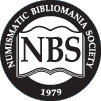 The NBS Symposium will be held on Thursday, August 15, from 11:30 to 1:00 p.m. in Room 6 of the Stephens Convention Center. Our special guest speaker will be Karl Moulton discussing his new book, "John J. Ford and the Franklin Hoard".
The NBS Symposium will be held on Thursday, August 15, from 11:30 to 1:00 p.m. in Room 6 of the Stephens Convention Center. Our special guest speaker will be Karl Moulton discussing his new book, "John J. Ford and the Franklin Hoard".
The NBS General Meeting will be held on Friday, August 16, from 11:30 to 1:00 p.m. in Room 24 of the Stephens Convention Center. We will have presentations from authors (including Bill Bugert) on their new books, reports from the ANS and ANA Librarians, presentations of the Joel Orosz and Jack Collins Literary Awards, installation of new officers, and an auction of important numismatic literary works that have been donated by our members.
We hope these events will be well attended by Young Numismatists, collectors, and bibliophiles, and if past conventions are any indication of future events, the meetings should be informative and spirited.
John Burns Numismatic Literature
Literature dealer John Burns reports that he will be set up at the show at Tables 1351-1352.
Reed Book Signing
Fred Reed writes:
I've got a signing in downtown Chicago on Saturday at noon the last day of the upcoming ANA convention for my new book, Abraham Lincoln: Beyond the American Icon. The event will be held at Abraham Lincoln Book Shop, 357 West Chicago Avenue, Chicago, IL 60654 p. (312)944-3085 f. (312)944-5549.
E-Sylum readers can attend the event on their computers. It will be broadcast live and listeners can send in questions that moderator Dam Weinberg will ask the author. The format of the presentation is for the moderator to interview the author. A live audience will also be present to ask questions of the author. Listeners can also order autographed copies of either of my Lincoln books. Those attending the ANA convention are especially invited, but any E-Sylum reader can tune in on www.virtualbooksigning.net
1792: Birth of a Nation's Coinage
Len Augsburger writes:
On Thursday, at 3pm, Joel, myself, and Pete Smith will have a Money Talks presentation, "1792: Birth of a Nation's Coinage" in which we will cover our latest research on the 1792 half disme.
In our presentation we will reveal some surprising findings about when and where the 1792 half dismes were struck.
The Numismatourist
Howard Berlin, aka The Numismatourist, will give a “Money Talks” presentation at the ANA World’s Fair of Money in Chicago at 4:00pm on Thursday (August15) in Room 13 of the Donald E. Stephens Convention Center. The topic is: When Traveling, Visit a Museum Having a Numismatic Exhibition. Much of the presentation is based on his soon to be released book, “The Numismatourist: The Only World-Wide Travel Guide to Museums, Mints, and Other Places of Interest for the Numismatist.” All E-Sylum readers are welcome to attend.
Paul Hybert, with the Local Exhibit Committee writes:
From the recent issues, I cannot determine if you will be visiting the ANA Convention in suburban Chicago, near O'Hare Airport. On the chance that you might be undecided, maybe I can tempt you with some of this year's Collector Exhibits.
From mentions in the E-Sylum of medals for heroism and things from Pennsylvania, "Pennsylvania Railroad Heroic Service Medals" should interest you. "Dr. Daniel W. Valentine: Profile of a Numismatic Pioneer" should appeal to your interest in numismatists of the past, and "Laban Heath's Counterfeit Detector Microscopes" should appeal to the ephemera collector in you.
Among the eye-catching titles, we have "I Collect Weird Stuff" and "Hwenne Gold Was Smite in Coign." Let me know if you need more convincing -- fifty more exhibits will be on display.
NEW BOOK: ANATOMY OF AN INGOT
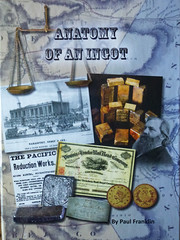 “Rarely do you find books on assayers of the early mining rushes of the West, however, Paul Franklin has just released a volume on three of these largely forgotten individuals, Mathey, Kustel and Riotte. The author’s curiosity was raised when the three names surfaced on a unique silver ingot in one of the many auctions of the famed numismatist, John J, Ford Jr. The story of the mystery silver ingot and the investigation into their lives is an exciting journey that takes you back to the early mining days of the West. Their careers, spanning the second half of the 19th century, intersected much of the early mining history in California and the territories of Arizona and Nevada in addition to meeting some of the important figures of the period.
“Rarely do you find books on assayers of the early mining rushes of the West, however, Paul Franklin has just released a volume on three of these largely forgotten individuals, Mathey, Kustel and Riotte. The author’s curiosity was raised when the three names surfaced on a unique silver ingot in one of the many auctions of the famed numismatist, John J, Ford Jr. The story of the mystery silver ingot and the investigation into their lives is an exciting journey that takes you back to the early mining days of the West. Their careers, spanning the second half of the 19th century, intersected much of the early mining history in California and the territories of Arizona and Nevada in addition to meeting some of the important figures of the period.
The most significant of the three assayers was Guido Kustel, who worked in the early San Francisco assay business with well-known names such as Wass, Molitor and Harazsthy. A German trained Mining Engineer and Metallurgist, Kustel ventured off to the Apache infested mountains of Southern Arizona to build the first assay and refining facilities at the famous Heintzelman Mine. He returned to California just in time to become one of the principal players in the early Comstock mining boom in Nevada. Although not a household name today, Kustel was one of the most famous mining engineers and assayers of his day, publishing three books that became ‘must haves’ for every mining engineer. He returned to San Francisco where he set up a number of assay offices and refineries.
The second player was Eugene N. Riotte, also trained in Germany, who travelled to Nevada just in time to participate in the newly discovered Reese River silver mines around Austin. He was later involved with a number of other assayers and mining engineers in solving the problems in refining the complex silver ores of Nevada.
The third member, Henry Mathey, emigrated from the gold mines of South America to the early mines of Darwin near Death Valley. Joining Kustel and Riotte in 1880 they set the stage for the origin of the silver ingot in question, but not in a way that one might have guessed. Mathey would go onto other achievements including developing the first tin mine in the United States.
Along the way you meet a number of interesting and perhaps familiar names:
- Wass Molitor & Co, assayers and pioneer gold coiners;
- Aguston Haraszthy, first assayer of the San Francisco Mint and father of the California wine industry
- Samuel Heintzelman, Arizona pioneer, miner and Civil War Major General
- Samuel Butterworth, superintendent of the New York Assay Office and president of the New Almaden Quicksilver Mine in San Jose
- Samuel Colt of the Colt Arms Co.
- J. Ross Browne, western chronicler, world traveler, explorer and secret agent for the Treasury Department.
- Almarin B. Paul, Mining Entrepreneur in California and the Comstock
- William Sharon, Banker to the Comstock
- C. A. Luckhardt, Assayer and Bogus Mining Stock Promoter
- Thomas Edison
- President Benjamin Harrison
- Jose F. Navarro, one of Americas least known entrepreneurs responsible in part for the Panama Canal and a host of multi-billion dollar companies
The book is lavishly illustrated with 145 illustrations, (many published for the first time) and over 550 references on 251 pages of high quality glossy stock. The author has mainly used primary resources in researching the book and provides a richly detailed bibliography. At the end are a number of appendices, one which traces the history of assaying and provides descriptions of the processes as practiced during the period. The book, self-published, is priced at $39.95 and can be purchased by contacting Paul Franklin at pgfranklin@charter.net or calling 775-849-0295.
NEW BOOK: LA MONEDA CUBANA EN CIRCULACION
 NEW REFERENCE BOOK ON CUBAN COINS NOW AVAILABLE
NEW REFERENCE BOOK ON CUBAN COINS NOW AVAILABLE
The book's title is "LA MONEDA CUBANA EN CIRCULACION'' and has been published by the Spanish editorial ''Cultivalibros". It is available at several online platforms for an attractive price of 15 euros, plus handling. The writer, Roberto Menchaca, has also kept some of the books, which could also be purchased directly from him for 10 euros, plus shipping.
Roberto reports that “It took me some effort and a trip to Cuba to unveil the mysteries of the CUC and INTUR coinages. Fortunately, the staff of the Cuban Numismatic Museum was very cooperative. The book is only available in Spanish (i.e. my mother tongue) but I am planning in the future to translate it into English depending on the actual demand”.
The book is 104 pages and deals with the history associated to the different stages of the Cuban coinage starting from 1915 till 2012 including a chapter dedicated to CUC coins and another covering the INTUR emissions. It also contains annexes dedicated to the patterns of 1870 and the 1897/8 emissions. Finally, there is an accurate table enclosing all the years in which Cuban coins have been minted listed by denominations and mints in charge (where all mistakes appearing in the Krause catalogue have been removed).
Questions should be directed to Roberto Menchaca at romega73@yahoo.es. Feedback, etc, should be directed to lamonedacubanaencirculacion@yahoo.es.
To order a copy, see any of these online outlets:
www.deastore.com
www.cultivalibros.com
www.liberialuces.com
NEW BOOK: MONEY OF THE BIBLE, 3RD EDITION
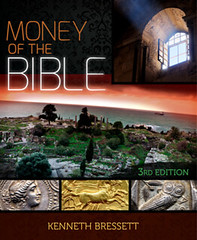 Publishing announces the release of the expanded and revised third edition of Kenneth Bressett’s award-winning Money of the Bible. The 120-page hardcover coffee-table book will debut at the American Numismatic Association World’s Fair of Money in Chicago, August 13–17, 2013. Bressett will be on hand to autograph copies at the Whitman Publishing booth. After the show, Money of the Bible will be available online (including at www.Whitman.com) and from bookstores and hobby shops nationwide. Its retail price is $29.95.
Publishing announces the release of the expanded and revised third edition of Kenneth Bressett’s award-winning Money of the Bible. The 120-page hardcover coffee-table book will debut at the American Numismatic Association World’s Fair of Money in Chicago, August 13–17, 2013. Bressett will be on hand to autograph copies at the Whitman Publishing booth. After the show, Money of the Bible will be available online (including at www.Whitman.com) and from bookstores and hobby shops nationwide. Its retail price is $29.95.
“Money and coins are mentioned many times, and in many places, in the Old and New Testaments,” Bressett said. “They give us a running commentary on biblical events in a way that no other artifacts can supply.” He presents their stories and explores their relevance in the updated third edition of Money of the Bible, which includes expanded text and many additional and upgraded photographs.
The first edition won the 2006 “Best Specialized Book, World Coins” Award from the Numismatic Literary Guild. BookIdeas senior editor John L. Hoh called it “a wonderful reference book for church libraries.” Ancient-coin specialist David L. Vagi praised “the clarity of the text and the lavish illustrations,” saying that “experienced numismatists will enjoy Mr. Bressett’s careful investigations of theories and the finer points of evidence.” Author and scholar Dr. Paul Rynearson, who wrote the book’s foreword, said, “This reference makes coins come alive, visually expanding Biblical texts, while the beautiful photographs of historical places and artifacts make the words resonate in our hearts. You will discover fascination on every page.”
Bressett, perhaps best known as the longtime editor of the annual Guide Book of United States Coins (the “Red Book”), has also researched and written about English coinage, ancient Greek and Roman coins, U.S. paper money, grading standards, buying and selling coins, and many other hobby topics.
In Money of the Bible he studies how the Bible was written, and its nature; commerce before coins; coins of Old Testament times; coins in the New Testament; first-century money and trade; coins mentioned in Jesus’ parables and lessons; coins and the Passion of Christ; the beginning and spread of Christianity; and how to collect coins with Biblical themes. A detailed index of terms and Bible verses rounds out the text and its full-color photographs.
“In Money of the Bible, Kenneth Bressett opens a window onto everyday life in the ancient world,” said Whitman publisher Dennis Tucker. “Parables like that of the moneychangers in the Temple take on new meaning when you’re looking at the actual coins people used in Biblical times.”
Illustrated essays examine the money the Good Samaritan would have used to pay the innkeeper; anti-Semitic insults used on Roman imperial coins; early images of Christ and angels; why a fish might have a silver coin in its mouth; and many other fascinating topics.
Narratives new to the third edition explore the beginning of Christianity and its early distinction from Judaism; the conversions of the Axumite kingdom and of Armenia; Jewish uprisings under Roman emperor Trajan; cherubim, seraphim, and lammasu; the recovery of the True Cross by Byzantine emperor Heraclius; Arab-Byzantine conflicts; and an expanded section on collecting coins with Biblical topics.
Among the dozens of new coin photographs are those illustrating Hadrian at Alexandria, the Colossus of Rhodes, and a Macedonian peace design; a silver shekel of Byblos; a Roman silver denarius of Marc Antony; early electrum money units; a heathen coin of the sea god Poseidon; a coin of the nightmarish emperor Caius Caligula; and many others.
Money of the Bible: A Numismatic Chronicle of Events, 3rd edition ∙ Kenneth Bressett ∙ Foreword by Paul Rynearson ∙ ISBN 079483955X ∙ 120 pages ∙ Coffee-table (10 x 12 inches) hardcover with dustjacket ∙ Full color ∙ Retail $29.95
For more information, or to order, see: Money of the Bible - 3rd Edition (/www.whitman.com/store/Inventory/Detail/Money-of-the-Bible---3rd-Edition+079483955X)
THE BOOK BAZARRE
INDIANA COIN CLUB DONATES NUMISMATIC BOOKS TO LOCAL LIBRARY

Librarian Chris Retseck, center, accepts a donation of 27 books about coin and paper money from members of the Calumet Numismatic Club, from left, co-Vice Presidents Noel Rodriguez and Ken Fehlberg, Treasurer Neal Slager and Book Coordinator Paul Beck. Not pictured are the club President Wally Loosinieck and co-Book Coordinator Larry Dora and Joe Pollock.
The Calumet Numismatic Club of Lake County, with the assistance of the Central States Numismatic Society, recently donated 27 books about coins and paper money to the Munster branch of the Lake County Public Library. A nameplate reading "Donated by the Calumet Numismatic Club" has been added to each of the books, and they are available to all patrons with a valid library card throughout the 13 branches of the Lake County library system. The Central State Numismatic Club offers a reimbursement program to member clubs purchasing books as donations. The Calumet club, founded in 1939, meets at 6 p.m. on the third Wednesday of the month at the Munster branch library, 8701 Calumet Ave., and visitors are always welcome. For more information, contact the club at: Calumet Numismatic Club, P.O. Box 171, Schererville, IN 46375.
To read the complete article, see: Oldest coin club in Indiana donates books to library (www.nwitimes.com/news/local/lake/munster/oldest-coin-club-in-indiana-donates-books-to-library/article_19c08721-2b5d-54e5-bdd0-29b0e2b90cc4.html)
SCHENKMAN TO RECEIVE 2013 FARRAN ZERBE AWARD
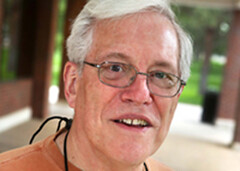 Noted token expert David E. Schenkman is the 2013 recipient of the American Numismatic Association's Farran Zerbe Memorial Award. The Association's most prestigious award is given in recognition of numerous years of outstanding, dedicated service to numismatics. He will be presented with the award at the World's Fair of Money during the ANA banquet from Aug. 16 at the Hyatt Regency O’Hare.
Noted token expert David E. Schenkman is the 2013 recipient of the American Numismatic Association's Farran Zerbe Memorial Award. The Association's most prestigious award is given in recognition of numerous years of outstanding, dedicated service to numismatics. He will be presented with the award at the World's Fair of Money during the ANA banquet from Aug. 16 at the Hyatt Regency O’Hare.
Schenkman has shared his knowledge of tokens with collectors since his first article was published in the early 1960s. His eight books are each considered a standard reference. He has been a columnist and contributing editor for The Numismatist for many years, and he received ANA Heath Literary Awards in 1994 and 2013.
“I got absorbed in numismatics at a young age, and I’m still very absorbed today,” Schenkman said. “It’s like I tell people when I teach classes: It’s not having something, it’s finding it. No matter what a numismatist collects, there’s always a goal. And once that goal is reached, you need another goal.”
He edited the Token and Medal Society publications for 27 years, the Civil War Token Society journal for five years, and he served as president of both clubs. Schenkman also is a member of the American Vecturist Association, National Scrip Collectors Association and Numismatic Literary Guild.
In addition to teaching ANA Summer Seminar students about U.S. tokens and Civil War-era numismatics for 18 years, Schenkman has presented many talks at the Association's conventions. He has prepared competitive exhibits at state, regional and national shows, taking home a number of awards. He received the ANA Glenn Smedley Memorial Award in 2003 and Medal of Merit in 2007. He received the ANA Lifetime Achievement Award during the 2012 World’s Fair of Money.
Schenkman is currently working on two books. One is a catalog on obsolete paper notes related to the mining industry. The other is the second edition of his book “Virginia Tokens,” which was originally published in 1980. Schenkman notes that the second edition will nearly double the size of the original publication with new material.
“You can’t learn it all, you can’t know it all. There are always new collector paths to go down,” Schenkman said. “I’ve collected a lot of different things. There’s just no end to the way you can approach numismatics.”
See the August issue of The Numismatist for a feature story on Schenkman and his many numismatic achievements.
THE 2013 HEATH AND MISHLER AWARDS
A couple other E-Sylum regulars won awards this year. David Fanning's article "Top 10 American Numismatic Books", has been selected to receive the third-place Heath Literary Award for 2012. Congratulations!
The Heath Literary Award, introduced in 1949 and named for George Heath, ANA founder and the first editor of The Numismatist, recognizes outstanding articles published in the last year in the journal.
The awards will be made during the ANA World's Fair of Money in Chicago on Thursday, August 15.
Clifford Mishler writes:
This is an award that I originated back in the early 1970s, providing the endowment to get it going through the Token and Medal Society. I presume that original endowment ran out long ago, so for many years the TAMS was probably absorbing the annual costs. In recent years, as the TAMS has found itself financially strained, I’ve made a couple personal funding donations to keep it going. Thus, it is an award that is bestowed annually, I believe as first, second and third place achievements, to the top cataloging efforts published in a given year, which may be an original work or a revision of a previously published work. At least those were my original intentions, but I’m not certain of the specific criteria that might be observed by the judging committee these days, as I have not participated as an ingredient of that body for years.
ARTICLE PROFILES BASEBALL COIN DESIGNER CASSIE MCFARLAND
 San Luis Obispo, Calif., artist Cassie McFarland wasn’t aware until May 11 that the U.S. Mint was soliciting designs for a common obverse for the 2014 National Baseball Hall of Fame commemorative coins.
San Luis Obispo, Calif., artist Cassie McFarland wasn’t aware until May 11 that the U.S. Mint was soliciting designs for a common obverse for the 2014 National Baseball Hall of Fame commemorative coins.
Today, her design appears to be the clear favorite for the three coins in the program — not bad for someone who almost missed the contest.
McFarland stumbled upon the U.S. Mint’s Baseball Coin Design Competition on the contest’s last day for potential designs to be submitted.
McFarland, 27, had been browsing the Internet looking for information on a series of Shell service station “Mr. President” tokens depicting U.S. presidential portraits that she recalls having collected while growing up.
A figurative oil painter, portraitist and sculptor, McFarland was seeking the token designs as inspiration for an art project she had conceived.
The baseball commemorative coin design contest link showed up during one of her Internet searches.
“I guess I typed in the right information [in the search engine],” McFarland told Coin World July 22.
Now the design that she submitted in competition with 177 other design hopefuls is just two steps away from possibly receiving final approval, after receiving the recommendations July 18 and July 23, respectively, of the two congressionally authorized review panels — the Commission of Fine Arts and the Citizens Coinage Advisory Committee.
Final approval by Treasury Secretary Jacob J. “Jack” Lew or his designee would mean a permanent place for McFarland in U.S. commemorative coin history, her initials on the obverse of three commemorative coin denominations, and compensation of at least $5,000.
To say that McFarland is ecstatic about the prospects would be an understatement.
“Oh my goodness, that’s crazy. What are the chances?” McFarland said upon learning the news. “This is all very surreal for me. I’ll have to take it one step at a time.”
McFarland submitted her proposed design to Batterup.challenge.gov on May 11, the final day of the 30-day design competition that began April 11.
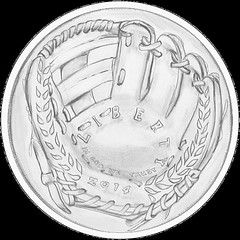 McFarland said July 23 that after locating the Mint’s coin design competition and reading the contest rules, she quickly put pencil to paper to execute a rendering that would work well if struck in a concave format. What better way to recognize the game of baseball than a baseball glove?, McFarland said.
McFarland said July 23 that after locating the Mint’s coin design competition and reading the contest rules, she quickly put pencil to paper to execute a rendering that would work well if struck in a concave format. What better way to recognize the game of baseball than a baseball glove?, McFarland said.
McFarland also believed her design would pair well with the common, convex reverse depicting the type of baseball used in Major League Baseball.
McFarland incorporated both two-dimensional and three-dimensional elements to make her contrasted design challenging to the eyes.
“I played softball as a kid and had a somewhat round glove,” McFarland said. “I wanted to make the design spheric, but still appear concave. The bumps of the laces and the wheat and concavity — I think they provide a realistic feel of holding a glove.”
To read the complete article, see: Baseball designer almost missed competition (www.coinworld.com/Articles/ViewArticle/baseball-designer-almost-missed-competition)
ARTICLE PROFILES JIM HALPERIN OF HERITAGE AUCTIONS
Halperin, co-founder of Heritage Auctions, has been in business almost all his life.
Halperin’s association with coins began the summer before his senior year of high school when he converted his print shop into a stamp business. Wanting to attract a wide customer base, he brazenly named it Jim’s Stamp & Coin Shop, even though he didn’t know anything about coins.
But when Gary Walls walked into the store and asked about coins, Halperin had to admit he didn’t have any. So Walls volunteered to help get the coin business off the ground, and almost immediately became Halperin’s new company’s first employee.

It wasn’t long before Halperin was studying Numismatic News, Coin World, the Red Book and using Brown & Dunn for grading. What he quickly learned was that he had an affinity for coins.
“Every time I saw a coin I remembered what it looked like,” he said. “When I saw another one, I remembered whether – and why – it was better or worse than the first one.”
During his senior year at Middlesex School in Concord, Mass., he ran the coin business in the afternoons, attended coin shows on weekends and amassed an inventory of about $100,000 with no debt.
But more opportunity lay ahead. Halperin was accepted into Harvard University.
“Harvard was great,” he said. “One thing about it though was that I was no longer the smartest person in the room. I didn’t like that. But even worse, I couldn’t attract a girlfriend to save my life. I had gone to an all-boys private high school and I didn’t know how to talk to women at all. And I loved coin dealing.”
So, after three semesters he told his Dad he was leaving school to sell coins full-time and opened New England Rare Coin Galleries in Framingham, Mass. That was late 1971.
Halperin gives credit to a number of coin dealers who helped him out and offered advice in those early years. Dealers like Joe Lipson, and Ed Leventhal of J.J. Teaparty, who took him to his first coin show away from home.
“Coin dealers were, and still are, very nice to new colleagues,” Halperin said.”
Then there was the tall Texan, Steve Ivy, whom Halperin met when Ivy was 19 and already a famous coin dealer. Halperin was 16 at the time. The friendly rivals continued to keep in touch.
The late 1970s were magic for New England Rare Coin Galleries. At its peak it employed almost 200 people and brought in close to $35 million annually. It was doing so well, in fact, that in 1979 Sotheby’s came calling and offered Halperin $22 million for his company. Halperin declined.
But with the good comes the bad, and within a few years the company that Sotheby’s had coveted was now insolvent – almost $2 million under water.
“I was unwilling to consider bankruptcy,” Halperin said, “and determined to pay all of New England’s creditors in full.”
Fortunately, Halperin wasn’t alone. His Texan friend and rival Ivy called because his business, although in better shape than Halperin’s, wasn’t doing all that well either. Ivy’s proposal was to join forces, move Halperin’s operations to Dallas and cut overhead expenses. That was 1982.
“It’s one of the best things I ever did,” Halperin said.
Along with the wholesale coin business, Halperin brought his auction company to Dallas where Bob Merrill, who ran Heritage’s auctions, rolled it into the business.
To read the complete article, see: Halperin Put His Stamp on Coins (www.numismaster.com/ta/numis/Article.jsp?ad=article&ArticleId=27092)

BANKNOTES AND TRAVEL IN 1850S AMERICA
New York and Massachusetts banks operated in states with good bank regulations that resulted in well-run banks. As a result, their banknotes were in common circulation in their local areas. As you observed, the farther one travelled from the city of issue, the larger the discount on the banknotes, because anyone wishing to exchange the banknote for specie would have had to undertake the expense to travel to the city of issue to exchange the banknote for gold coin.
For a resident of New York City, his everyday money would have been local banknotes. As you suggest, I expect that a smart New Yorker would have gone to a money broker to purchase, at a discount, banknotes that would have circulated at par in Nantucket.
Depending on the size of the banks on or near Nantucket, I suspect he might have purchased banknotes issued by a Providence bank, as money from the nearest city might very well have been the circulating medium on Nantucket.
Alternately, he might have gone to a New York bank to purchase some gold coins - which would have been accepted wherever one travelled. By 1850, gold coins were readily available in larger cities.
For example, In J.S. Holliday's The World Rushed In, which is based on the diary of William Swain, a '49er from the Buffalo, New York area, Mr. Swain describes purchasing gold coins for his journey to California in April 1849 at a Buffalo bank for only a 1% premium in local banknotes.
A bank in New York City in 1850 would have had a ready supply of gold coins on hand for their customers who were importers, as customs duties were required to be paid in specie.
As you know, the real difficulty for anyone in 1850 would have been in obtaining smaller denomination coins, as the California Gold Rush had resulted in silver coins being more highly valued as bullion than as coins and, therefore, disappearing from circulation.
Dave Bowers mentions, in his Obsolete Paper Money, that Nantucket, being a whaling port, was an early home to a bank. Whether a New York City money broker would have had any Nantucket banknotes in stock, however, would have depended on the patterns of commerce at the time.
Banknotes from Boston might have also passed at par on Nantucket, again depending on the patterns of commerce at the time. It seems reasonable that a New York City money broker would have had Boston banknotes in stock.
Shurouq writes:
Thanks very much for this information, we are all finding it quite fascinating! If we can get any images of these notes (from any banks mentioned), it would be very helpful.
To read the earlier E-Sylum article, see: QUERY: 1850S AMERICAN PAPER CURRENCY IMAGES SOUGHT (www.coinbooks.org/club_nbs_esylum_v16n32a11.html)
NOTES FROM E-SYLUM READERS: AUGUST 11, 2013
Humor Rubs Ron Wrong
Ron Guth writes:
I fear the E-Sylum might have been hacked by the likes of Anthony Weiner or Bob Filner (our mayor here in San Diego). using the name "Editor." That's the only explanation I can think of for the "addadictomy" reference in the latest issue.
To read the earlier E-Sylum article, see: JANE AUSTEN BANKNOTE PROMOTER THREATENED (www.coinbooks.org/esylum_v16n32a15.html)
Meteorite Nitpicks
Last week I quoted an article about the meteorite fragments to be placed in certain Olympic gold medals:
Earlier this year, a meteor the size of a bus slammed into the Russian city of Chelyabinsk with the force of 20 atom bombs
Unable to contain himself, John Burns sent this note:
It didn't SLAM into the freakin' city, it was an airburst, ohhhh and how BIG ISSSSSSSSSSSS an atom bomb?????
John added:
The people of Chelyabinsk were extraordinarily lucky - the detonation occurred at approximately 20-40 miles up with an estimated blast of 500 kilotons. If this had occurred 4-5 miles above it would have obliterated the city with hundreds of thousands dead. The problem with saying "atom bomb" is they can range from a few kilotons to the monster TSAR BOMBA of 50 MEGATONS the Russians detonated in the early sixties.
To read the earlier E-Sylum article, see: SOME OLYMPIC GOLD MEDALS TO CONTAIN RUSSIAN METEORITE FRAGMENTS (www.coinbooks.org/esylum_v16n32a13.html)
Leonard Questions Three Dollar Gold Mintage
Regarding the auction lot description quoted last week, Bob Leonard writes:
The lot description stated:
During its entire thirty-five year production from 1854 until 1889 only about 16,300 three dollar gold pieces were produced in total (compared, for example, with the nearly 600,000 Quarter Eagles struck in Philadelphia in 1854 alone).
Bob Leonard writes:
I can't imagine where this number came from: per the Red Book, the 1854 alone has a mintage of 138,618, and there are seven other dates with mintages above 16,300 each. (I will leave to someone else with more time on their hands to total the entire mintage.)
To read the earlier E-Sylum article, see: BONHAMS TO SELL TACASYL U.S. PROOF GOLD COINS (www.coinbooks.org/esylum_v16n32a10.html)
The Man Who Almost Bought a 1913 Liberty Nickel
Dave Hirt writes:
The picture of the 1967 ANA auction catalog brought back memories to me. The 1913 Liberty nickel purchased by Aubrey Bebee was lot 2214. Of course that item was way, way out of my league, but I have always thought I came as close to it as I could, being the winning bidder on the previous lot, 2213, a 1912-S nickel.
QUERY: HAYMARKET TOKEN MARKING PUZZLE
Web site visitor Seth B. ( RedNBlack77@yahoo.com ) writes:
I was researching the Chicago Haymarket Riot tokens, as found on your site, because I used to own one. I am a labor history buff and purchased it off eBay years ago. I used to carry it with me in my pocket as a charm of sorts and lost it while visiting friends in Chicago.
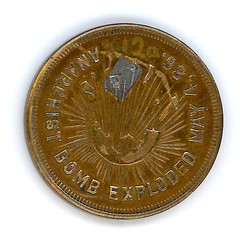 The funny thing is that I believe that my particular token ended up at the Chicago Historical Society, as the one I had had a strange mark on one side that looked like "12a" (as pictured here).
The funny thing is that I believe that my particular token ended up at the Chicago Historical Society, as the one I had had a strange mark on one side that looked like "12a" (as pictured here).
Anyway, I would love to know what it may be worth and how to get another one. Your site has been the only other online resource, other than the Chicago Historical Society, that I have come across to know of these tokens. Any help or information you could offer would be fantastic. Many thanks.

To visit the Chicago Historical Society database entry, see: Souvenir token of the Haymarket Square Riot. -- Front view (www.chicagohistory.org/hadc/visuals/artifact/011A11A.htm)
To read the earlier E-Sylum article, see: BOMB BLAST NUMISMATIC SOUVENIRS (www.coinbooks.org/esylum_v16n17a07.html)
THE BOOK BAZARRE
EBAY STILL BANS CUBAN COINS AND BANKNOTES
The eBay fiasco began on April 9, 2013. Word began trickling in that eBay was rejecting listing of certain Cuban collectibles. Surely, it had to be a mistake. Maybe eBay was enforcing the vulnerable point of the Cuban Embargo? Maybe the intent was to discourage sellers from listing coins, currency, and unused stamps minted under Fidel Castro’s rule (identified as the Second Republic in Numismatic terms)? WHY? Why would eBay introduce changes in their own guidelines after 10 years? There had to be a logical answer to this policy change!
Unfortunately, after more information was received from many CNA members whose listings were rejected, it became obvious that ALL Cuban collectibles were being rejected by eBay. Even cancelled stamps, known as informational, which are specifically excluded from the Cuban embargo, were rejected by eBay. WHY?
Needless to say, this biased policy resulted in many complaints to eBay management. Formal letters to eBay executives, emails, and telephone calls to Customer Service Representatives produced no reason WHY the new policy was introduced. Telephone calls to the eBay executives were impossible because the eBay telephone system does not provide access to the executive branch. Word was received that eBay customer reps were telling callers that eBay was unable to differentiate between First Republic collectibles (1915-1961) and Second Republic collectibles (1962-current), so THE BLANKET BAN was applied. They added “As a company, eBay can do anything they want and they will apply their new policy”.
My own April 25, 2013 registered letter to Mr. Michael R. Jackson, eBay Senior VP, General Counsel, was answered on May 23, 2013 by an aide, Mike Carson, Global Regulatory and Policy Management. His response is as follows:
“Thanks for your recent letter regarding eBay’s policy on Cuban-origin items. As you know, eBay’s Embargoed Goods Policy prohibits the sale of most items from Cuba (except for informational items) and does include a prohibition on the sale of stamps, coins and paper money from Cuba. While some of these items may have been made prior to the introduction of the embargo, eBay cannot determine when the item was actually removed from Cuba and therefore has made a policy decision to prohibit all such Cuban-origin items. We are not able to rely on disclaimers in the listing that the item is “pre-embargo” and we are in the process of updating our external policy to clearly state that. We have also removed the Guide to Collecting Cuban Coins.
Thanks again for the information you provided.”
I personally find the above position insulting, unprofessional, and an amateur attempt to cover up the true reason for the policy change.
I want to commend a few CNA members who have spent countless hours and their talent in an attempt to resolve this issue. Orlando Pino has written many letters to eBay addressing pertinent issues such as the intent in the embargo regulations as it pertains to Cuban nationals, as well as empirical policy. He has also petitioned the US Department of the Treasury’s Office of Foreign Control (OFAC), asking for clarification regarding the sale of First Republic Cuban collectibles between a seller and buyer, both of which reside in the US.
Stan Klein, a CNA Director, wrote eBay, pointing out the extremes of the Cuban embargo, as it could apply from sugar, nickel ore, tobacco, coffee, rum, etc. J.G. Ash has written an extensive review of the contradictions of eBay’s new policy.
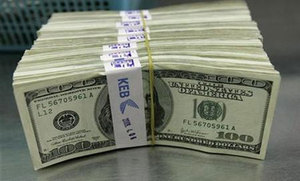
To view the eBay lot (if it's still posted, see: $1000 $100 Bill US Dollars AMERICAN USA (www.ebay.co.uk/itm/1000-100-Bill-US-Dollars-AMERICAN-USA-/261261164974?pt=UK_Coins_Banknotes_GL&hash=item3cd46101ae)
To read the earlier E-Sylum article, see: MORE ON EBAY'S BAN OF CUBAN COINS AND BANKNOTES (www.coinbooks.org/esylum_v16n18a11.html)
SOME NEW COINS DESIGNS: AUGUST 11, 2013
Netherlands Waterloo Commemorative
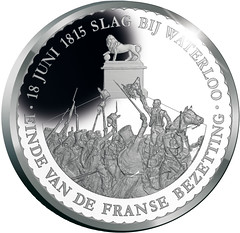
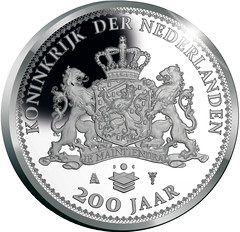
India Swami Vivekanand 5 Rupees
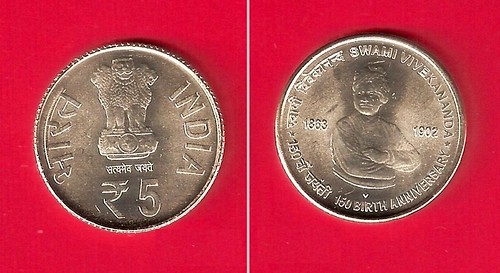
Here's another one where it's the pose of the subject that caught my eye - the arms folded stance is unusual in coinage. Are there many others like this?
Greece Pythagoras 5 Euros

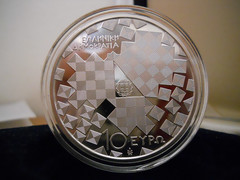
With my interest in the history of science and technology, I naturally liked this one with Pythagoras showing a visual proof of his famous Pythagorean Theorem stating that the sum of the squares of a right triangle is equal to the square of the hypotenuse. There. Never thought I'd get to use the word "hypotenuse" in The E-Sylum, but there it is. I guess everything IS connected back to numismatics in one way or another...
Sealand Prince Roy Commemorative
Pabitra Saha writes:
The Treasury of the Principality of Sealand has launched a commemorative memorial coin paying tribute to its founder and first Sovereign, Prince Roy, who died on October 9, 2012 at the age of 91.
In 1967, Prince Roy claimed a World War II-era decommissioned platform & defense tower located in International waters 6 miles off the southeast coast of the UK. The platform was declared sovereign territory by Roy who also proclaimed himself and his wife, Joan Bates as joint sovereign rulers on September 2 - his wife’s birthday.
Prince Roy is succeeded by his only son, the Prince Regent – now Sovereign Prince Michael.
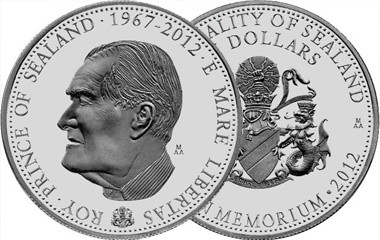
Austria Voralberg 10 Euro
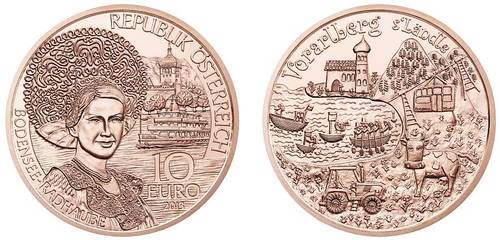
This one strikes me as a hideous abomination. Even forgetting that the reverse design is horribly busy, whatever is on or behind the woman's head on the obverse make it look like she's sporting a huge Afro. It's disturbing.
Argentina Bimetallic 1 Peso
Pabitra Saha writes:
Argentina has issued a bimetallic 1 Peso coin on bicentenary of Provincias Del Rio de la Plata.
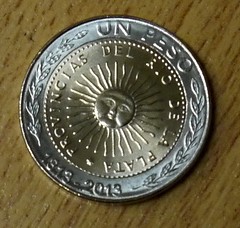

Nothing really special about this one, but maybe that's why I like it. It's a simple design that seems to work well in the bimetallic format. I've always likes the sun motif and appreciate what looks to me like a Liberty Cap on a pole on the reverse.
Czech Republic Benoit Blachut Commemorative
Pabitra Saha writes:
The Czech Republic has issued coin on 100 the birth Anniversary of opera singer Benoit Blachut.
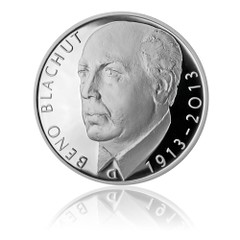
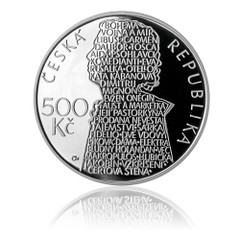
The reverse design is another representative of the "words as a design element" school. Often it works, but I don't think it does here. Too much, too flat. Doesn't work.
HARVEY STACK ON THE GEORGE O. WALTON COLLECTION. PART III
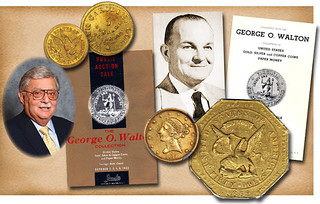 When the time came for Stack’s to present the George O. Walton Collection at auction, my cousin Norman and I were given the opportunity to catalog the Bechtler coins. There were close to 500 Bechtlers and we divided the group as follows: First we separated the A. Bechtler examples from those of C. Bechtler. We then divided these groups by denomination and then by variety including by die and wording variations. Although many were of varieties already listed in the Standard Catalog of U.S. Coins (Raymond) and the Guide Book of United States Coins(Whitman), new varieties and types were discovered among the Walton coins.
When the time came for Stack’s to present the George O. Walton Collection at auction, my cousin Norman and I were given the opportunity to catalog the Bechtler coins. There were close to 500 Bechtlers and we divided the group as follows: First we separated the A. Bechtler examples from those of C. Bechtler. We then divided these groups by denomination and then by variety including by die and wording variations. Although many were of varieties already listed in the Standard Catalog of U.S. Coins (Raymond) and the Guide Book of United States Coins(Whitman), new varieties and types were discovered among the Walton coins.
Once we had sorted and cataloged the October sale Bechtler coins by issuer, denomination and variety, we numbered each variety and assigned them an “S” number (Stack’s new variety number). We were able to offer, illustrate, and describe 26 different design varieties, for collectors who might want to try to collect them all. We took the best among the varieties and offered them individually. Next we tried to offer a type set of C. Bechtler coins and one of A. Bechtler coins. Then we combined the types. We tried to separate the pieces in a way that offered the most variety per lot, so that the buyers would have the beginning of a collection of varieties. Eventually we had to double up on the types and so on until we had them in as many lots as we could form. Our goal in this method was to give all interested buyers the opportunity to acquire something that would lead them to expand on the collection.
Walton also had an exciting group of other private and territorial gold coins, including issues of A. Humbert, Miners Bank, Baldwin, Schultz, Dunbar, Wass, Molitor, Kellogg, Oregon, Mormon, and Clark Gruber. His collection was monumental, not always the choicest, but the rarest specimens he could find.
In the same October sale we offered most of the other rare gold U.S. coins from $1 to $50, singly and in groups, including 100 different dates of $20 double eagles in one lot. We felt that sorting the gold into lots containing different dates and mints would attract collectors.
George Walton was a major contributor to the growth of numismatics through his ownership of so many rarities and his willingness to show them extensively at shows, clubs and to dealers he visited. While often remembered for the rare 1913 Liberty Head nickel he owned, his entire collection was impressive and was the main reason he was considered by many who knew him to be a legacy in numismatics.
To read the complete article, see: Remember When: George O. Walton, Part 3 (stacksbowers.com/Blogs/remember-when-george-o-walton-part-3.html)
To read the earlier E-Sylum article, see: HARVEY STACK ON THE GEORGE O. WALTON COLLECTION (www.coinbooks.org/esylum_v16n32a12.html)
COMMEMORATIVE BILL TO BENEFIT OLD SAN FRANCISCO MINT
Democratic Leader Nancy Pelosi introduced legislation in the U.S. House of Representatives on Friday to create an exciting new commemorative coins program to celebrate the centennial of the Panama-Pacific International Exposition, and the engineering feat that created the Panama Canal a century earlier. Joining Ms. Pelosi in supporting the Panama Canal and Pan-Pacific Exhibition Centennial Celebration Act, H.R. 2760 are 11 co-sponsors.
The 1915 Panama-Pacific International Exposition celebrated the completion of the Panama Canal and the 400th anniversary of the discovery of the Pacific Ocean by the Spanish explorer Vasco Nunez de Balboa. The fair was held for almost the full year, and was a significant factor in the economic recovery of San Francisco, which had been nearly destroyed by an earthquake and subsequent fire in 1906. Congress authorized the U.S. Mint to issue five different coins dated 1915 to be issued in connection with the Panama-Pacific International Exposition, which represent a high water mark for American commemorative coins. Produced at the San Francisco Mint, these were the first U.S. commemorative coins to bear the motto "In God We Trust,” and included the silver Panama-Pacific half dollar and four gold coins in denominations of 1 dollar, 2½ dollars, a 50 dollar round coin, and a 50 dollar octagonal coin.
The recently introduced bill authorizes a new program directing the U.S. Mint to issue coins closely resembling those of 1915 including for the first time, an octagonal $5 gold piece. Collected surcharges from the sale of the program’s coins will go to the San Francisco Museum and Historical Society for the design and construction of appropriate exhibitions in the San Francisco Museum, including the necessary adaptive reuse of the Old Mint, commemorating the Panama-Pacific International Exposition, as well as the development of appropriate exhibitions at the Palace of Fine Arts on the grounds of the former Panama-Pacific International Exposition.
”This legislation offers numismatists an exceptional opportunity to enhance a National Historic Landmark and numismatic icon -- The Old San Francisco Mint -- while giving collectors the opportunity to readily acquire the extremely popular and uniquely designed Panama-Pacific coins” said Dr. Donald Kagin, co-chairman of the American Money and Gold Rush Museum in San Francisco and board member of the San Francisco Museum and Historical Society. He further noted that the numismatic community is excited about this legislation and pledges to work to ensure it is enacted. To that end, he urges numismatists to contact their respective members in the U.S. House to urge them to immediately cosponsor H.R. 2760.
Don adds:
Please contact your respective Representative in the U.S. House and ask that she/he cosponsor H.R. 2760; the preferred method of contacting elected officials is by email or by phone. You can find the contact information for your Member of Congress at www.house.gov. When contacting them, please reference H.R. 2760, and urge their immediate support of the bill.
Thank you for your time and your support of this important numismatic legislation.
THE BOOK BAZARRE
MORE BABIES ON COINS
 In our last issue readers cited a plethora of coins picturing babies, in response to Fred Michaelson's quiz question. Fred writes:
In our last issue readers cited a plethora of coins picturing babies, in response to Fred Michaelson's quiz question. Fred writes:
After seeing these answers, it might make more sense to list coins that don't have a baby. A friend happened to send me a bunch of old photographs, including the attached image of Sacajawea and her child. The caption would be "I knew there would be some strings attached."
Tom DeLorey writes:
The Black Revolutionary War Patriots silver dollar shows a woman holding a baby on the reverse.
Steve Bishop writes:
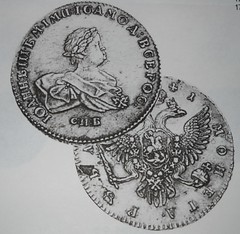 As a follow-up quiz to the one regarding babies on U.S. coins, how
about babies on non-U.S. coins? The one I know of offhand is Ivan III
of Russia, who, as an infant, was named heir to the Russian throne by
his great-aunt Empress Anna just before her death in 1740. His mother
acted as regent for a short reign until they were deposed in 1741. He
was jailed (at the age of two!) and remained so until he was murdered
in 1764.
As a follow-up quiz to the one regarding babies on U.S. coins, how
about babies on non-U.S. coins? The one I know of offhand is Ivan III
of Russia, who, as an infant, was named heir to the Russian throne by
his great-aunt Empress Anna just before her death in 1740. His mother
acted as regent for a short reign until they were deposed in 1741. He
was jailed (at the age of two!) and remained so until he was murdered
in 1764.
To read the earlier E-Sylum article, see: QUIZ ANSWERS: BABIES ON COINS (www.coinbooks.org/esylum_v16n32a06.html)
ROYAL CANADIAN MINT COMMEMORATES BIRTH OF PRINCE GEORGE
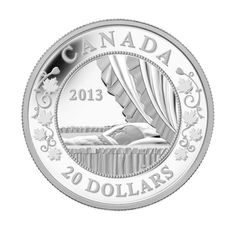 A series of coins fit for a king are available as keepsakes for Canadians who want to commemorate the birth of Prince George.
A series of coins fit for a king are available as keepsakes for Canadians who want to commemorate the birth of Prince George.
Today at Rideau Hall in Ottawa, Gov. Gen. David Johnston unveiled two collector coins and a collector coin set to mark the arrival of Prince George of Cambridge on July 22.
"It’s part of the excitement that we mark this moment of Canada’s future king," said Christine Aquino, spokeswoman for the Royal Canadian Mint in Ottawa. "It really captured the spirit of the new royal family member."
The coins include:
- A 25-cent silver coin with the Duke and Duchess’s names wrapped around the image of a carriage.
- A three-coin set of $20 coins. Two of them of feature a sleeping infant, while the third depicts an infant’s hand clinging to a mother’s thumb.
- A $5 silver coin with a gold plate at the centre, with initials of both the Duke and Duchess. Children’s toys are wrapped around the perimeter of the coin.
The coins were made at the Royal Canadian Mint in Ottawa, and approved by both Buckingham Palace and the Government of Canada. The coins can be purchased as collector kits, with prices ranging from $25 to $250.
To read the complete article, see: New coins celebrate birth of Prince George (/www.winnipegfreepress.com/breakingnews/New-coins-celebrate-birth-of-Prince-George-218899591.html)
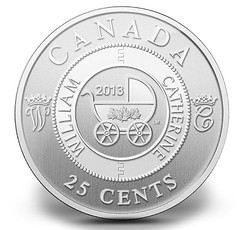
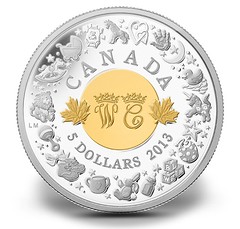
To read the complete article, see: Mint unveils new coin sets to honor royal baby (www.cjad.com/CJADLocalNews/entry.aspx?BlogEntryID=10576332)
MORE COIN DESIGN SIMILARITIES: BARBER AND WEINMAN
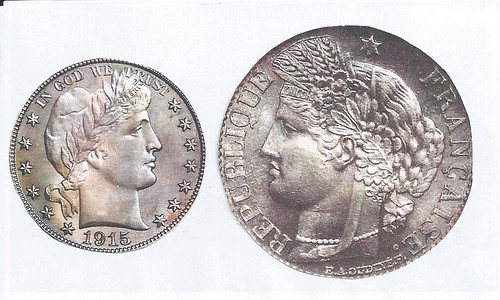
Charles Barber's obverse was dictated by Mint Director Edward Leech. He told Barber to pattern it after the French portrait of the Goddess Ceres, seen here on the One Franc coin. Barber wasn't too keen on the idea, but the boss insisted; and since he wanted to keep his job, Barber complied.
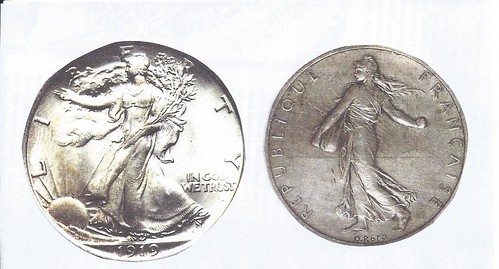
The other is Adolph Weinman's Walking Liberty Half. He was influenced by the French sower series. The sower of seeds was a popular icon in French art. The influence is obvious. The French may have given us some nice coin ideas, but what we showed them was of much greater significance: how to get rid of a tyrant.
MICROPATTERN ANTI-COUNTERFEITING IMAGES
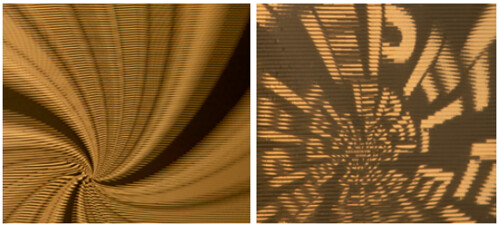
Chris Neuzil writes:
I saw a story in the July 25, 2013 issue of Nature that mentions the use of optical science against counterfeiting of paper money and labels on high-end products. The way things are going, PCGS may want to use it in their slabs.
Microscopic markings that are too small to be reproduced by standard printers can give rise to optical illusions, and could be used to mark authentic banknotes or luxury-brand goods.
Jürgen Brugger, Victor Cadarso and their group at the Swiss Federal Institute of Technology in Lausanne fabricated microscopic lines in rows or spirals (pictured, left) by patterning pixels in gold using ultraviolet light. When an array of tiny cylindrical lenses is laid over the lines, interference patterns produce images (pictured, right) of letters and other symbols. Copying these patterns, or moirés, would be difficult, the researchers say, because even micrometre-sized blemishes visibly distort the illusion.
To read the complete article, see: Micro-optical method thwarts counterfeiting (www.rdmag.com/news/2013/07/micro-optical-method-thwarts-counterfeiting?et_cid=3399527&et_rid=472507257&type=cta)
A FAIRBANKS, ALASKA POSTAL SAVINGS NOTE
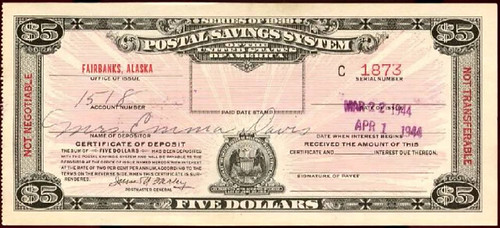
$5 Postal Savings System note issued at Fairbanks, Alaska. A small hoard of these Series of 1939 notes from the Fairbanks appear to be the only ones from Alaska to have survived. Primarily black and green, with a pink underprint. “Not Negotiable, Not Transferable,” Fairbanks and serial number in red, date stamps sort of purple. Size not reported. Offered on eBay as a buy it now for $6,000.
THE ONLY SURVIVING GOBRECHT DIE
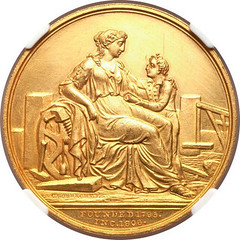 This all started at the Whitman Baltimore show in March, 2006. At that show, I purchased an example of the award medal commissioned by the Massachusetts Charitable Mechanic Association. This is a well known 19th century award medal, engraved by Christian Gobrecht in 1837. Somewhere in my disorganized office is a receipt from Tony Terranova indicating the pur-chase price was $350.
This all started at the Whitman Baltimore show in March, 2006. At that show, I purchased an example of the award medal commissioned by the Massachusetts Charitable Mechanic Association. This is a well known 19th century award medal, engraved by Christian Gobrecht in 1837. Somewhere in my disorganized office is a receipt from Tony Terranova indicating the pur-chase price was $350.
Shortly thereafter, I wrote a piece for the E-Gobrecht (Volume 2, Issue 4) noting that this particular medal was awarded to Enoch Robinson for exhibiting “AN IMPROVED DOOR / SPRINGS AND KNOBS” at the 1841 Association fair. At this point the power of the Internet kicked in and a gentleman from New York City, connected with a successor firm of Robinson, contacted me about purchasing the medal. I gathered that he actively purchased company memorabilia, searching on the Internet for whatever could be found.
Since I had a trip scheduled to New York anyway, I agreed to meet him in person at his place of business, which turned out to be a trendy loft setup in an even trendier part of town. I offered the medal at $1,000, which price was immediately accepted, and in retrospect I think could have added another zero on to the price and still made the sale. Money was left on the table, but the medal had gotten back to its proper home. In time I was able to acquire a replacement (in silver) from Q. David Bowers, and another in gold from the Ford collection.
Fast forward to 2013. When your coin dealer calls you up and tells you not to buy anything until you talk to him, you call back as soon as possible. In this case, the obverse die for the MCMA medal had appeared upon the great flea market of the Internet - eBay. I regularly check eBay for Gobrechtiana but in this case had not checked for a few days so my agent, John Kraljevich, beat me to it. After a quick phone call he agreed to represent me on the item. I nervously watched the item all week and called up John a few minutes before the auction expired, just to double check everything was solid with the bidding strategy. We agreed on our maximum bid and were successful in acquiring the die for substantially less. A week or so later the die landed at my local post office in good order.
The opportunity to acquire an uncancelled United States Mint die is a rare thing. A few such pieces exist in the ANA and ANS collections (described in
To read the complete issue, see:
E-Gobrecht Volume9, Issue8
(www.seateddimevarieties.com/103-E-GobrechtVolume9,Issue8.pdf)
A rare 126-year-old medal has been given to the prospective new owners of Dunfermline Athletic FC.
The medal, recently found at Halbeath Farm on the outskirts of Dunfermline and believed to be the oldest surviving artefact relating to the club, has been donated to the Pars United fans group by metal detecting enthusiast Les Hannah.
Inscribed Won by J. Lawson Dunfermline Athletic 1887 — just two years after the club had been founded — the medal is believed to have been presented to John Lawson, who played for a victorious Dunfermline Athletic side in the final of the 2nd XI Fife Cup, beating Kirkcaldy Wanderers 9-1 at Lady’s Mill (McKane Park) on April 23 1887.
Pars Supporters’ Trust vice-chairman and Pars United member Drew Main, said: “This is a truly magnificent gesture by Les at a time when the club is emerging from a very difficult period and embarks on a new era.
“We will ensure that the medal is put on display within East End Park so that fans can see such an important piece of Dunfermline Athletic history.
“Our research suggests that this might have been the John Lawson, who lived on the Pleasance Road, Halbeath, near where the medal was found. Sadly he was killed in a coal mining accident at the William Colliery, Crossgates, in 1906 aged 45.
The medal, therefore, also represents the coal mining heritage of many Dunfermline Athletic players and supporters.”
To read the complete article, see:
Rare 126-year-old Dunfermline cup winners’ medal unearthed
(www.thecourier.co.uk/news/local/fife/rare-126-year-old-dunfermline-cup-winners-medal-unearthed-1.119012)
I have just returned from a trip to Germany, where my wife and I attended the wedding of our oldest son to the daughter of the Bürgermeister (mayor) of a small town near Stuttgart. While there, we traveled to nearby Tübingen for a day trip to see some of the sights. The Eberhard Karls University (University of Tübingen) there, formed in 1477 is one of Europe’s oldest.
Another was that about half of the houses here on the 92 meter-long alley are timbered. Those built near the bottom of the alley near the town square are larger (for the wealthy and nobles) than those at the other end, near the St. George's Collegiate Church, were for the poorer residents.
At 13 Münzgasse, there is a sign in the window, “Hier kotzte Goethe“ (Goethe vomited/puked here), probably because the writer Johann Wolfgang von Goethe is said to have spent long evenings in the local taverns here.
While we were standing in front of the church, I turned around and saw a coin shop, Klassische Münzen (Classic Coins) at 15 Münzgasse (spelled on maps as one word), which is run by Dr. Michael Brandt. I wanted to go inside but, like museums in Europe on Mondays, it was closed. Although Brandt concentrates on ancient Greek, Roman, and Byzantine coins, in the store window were others of more recent vintage. This included notgeld coins from the Baden-Württemberg region, and a grouping of Kennedy half dollars
There was one interesting item about this building, however. There is a stone plaque on the side of the building that translates as: “Cotta House. Goethe lived here. September 7-16, 1797.” (Johann Friedrich Cotta was the major publisher of German classicism) Also in a second story window is a sign next to a small bust of Goethe that reads: “Goethe purchased his coins here… he was still living.”
Roughly 80,000 years of the history of civilization are presented in the Landemuseum Stuttgart since 2012 in this new permanent exhibition. A substantial part of it is in fact related to numismatics as we have noticed at our recent visit.
... the first evidence of money dates to a younger period of time i.e. to the turn from the Copper Age to the Bronze Age. Numerous hoard finds with standardized metal objects have been discovered, including spiral arm rings, ribs (bars) as well as fragments of a Cypriote copper ingot.
The exhibition’s presentation of the Roman coins needs some getting used to. Apparently, the architect pushed his concept through – and the enthusiasm of the architect for the beauty of the small things was likewise small, as it is clearly evident.
Any number of treasure troves have been found in Wuerttemberg, like the Köngen hoard consisting of 615 antoninians and denarii with the youngest piece dating to the era of Philippus Arabs (244-249).
To read the complete article, see:
A new exhibition in the Old Castle of Stuttgart
(www.coinsweekly.com/en/News/4?&id=2189)
Great rulers come but a rare few leave a mark echoing down the millennia. Two such were Cleopatra and Marc Antony, who fleetingly placed Egypt at the center of the ancient world, only to unleash unrest and eventually war on the region.
A few thousand years is a mere blink of an eye when it comes to the vital ties between this land and Egypt, as attested by a rare coin carrying historical weight far greater than its 7.59 grams, which depicts the notorious lovers – and which emerged last year from the ruins of a first-century house at Tel Bethsaida on the Sea of Galilee.
Tel Bethsaida rises from the northern coast of the Sea of Galilee, but the coin was minted in another city by another sea – the Mediterranean port of Akko - today better known as Acre. The coin, made of bronze, is about the size of a quarter, being 21–23 millimeters in diameter (it is not perfectly round, at least not any more). Its date shows that it was minted in the last half of the year 35 or the first half of 34 BCE.
Mark Antony, the most powerful man in the world at the time, is on one side of the coin and Cleopatra graces the other. On her side are the Greek words “of the people of Ptolemais.”
Why depict them? The cities of the ancient Middle East had a habit of minting coins bearing the portraits of whoever was in power, says Dr. Donald T. Ariel, head of the Israel Antiquities Authority Coin Department.
Had Antony not lost the battle of Actium in 31 BCE, there might have been a dramatic change in the history of the Western civilization, Arav says.
“We can only imagine what could have happened to Western civilization if the capital of the empire was not Rome, but Alexandria," Arav says. "Until Augustus turned it ‘from a mudbrick city to marble’ Rome was a very unimpressive town. It could have remained an unimportant city on an insignificant peninsula of Italy, way in the west, where according to the Greeks, demons and giants lived.”
When pressed to imagine what could indeed have happened, Arav, says: “I am not sure that we would be worshipping cats today or building pyramids, but Greek could have been much more important than it was and perhaps the rise of Europe in the 15th century would not have happened. Who knows?”
But Antony did lose that battle, and 11 months later, he took his own life, dying in Cleopatra's arms in an immortal star-crossed lovers’ moment.
To read the complete article (registration required), see:
The ancient coin of Cleopatra: There could have been pyramids in Paris
(www.haaretz.com/archaeology/.premium-1.539712)
An early-medieval gold pendant created from an imitation of a Byzantine coin that was found in a Norfolk field is a "rare find", a museum expert has said.
Discovered on land at North Elmham, near Dereham, the circa 600 AD coin was created by French rulers of the time to increase their available currency.
Adrian Marsden, finds officer based at Norwich Castle Museum, said the object was probably buried with its owner.
The pendant was declared treasure by the Norfolk coroner on Wednesday.
Mr Marsden added: "This is an early copy of a Byzantine gold coin made in France.
"The Merovingians [French rulers] created copies of Byzantine coins from their bullion as there wasn't enough coinage coming in from the eastern Roman empire. How many of these copies were 'official' currency is hard to say."
The 23.5mm diameter pendant, created from an imitation of a gold solidus of emperor Maurice Tiberius (582-602 AD), features a suspension loop with three longitudinal ribs having been soldered to the edge of the coin immediately above the emperor's head.
"What's interesting is you have somebody in France copying a Byzantine coin which then also followed the trend of turning it into jewellery."
Mr Marsden said the coin was likely to have come to England as a result of export trade at the time.
To read the complete article, see:
Norfolk medieval gold coin pendant 'a rare find'
(www.bbc.co.uk/news/uk-england-norfolk-23602056)
Many historians and numismatists mistakenly date the first Lao ingots to the first important king of Lan Xang in the 14th century. At that time and until the 19th century, only the kings and the elite of the country used ingots and coins. The remainder of the people used barter for most of their needs and sometimes cowrie shells to complete an imbalance in a transaction.
With Chinese and other neighbors’ ingots and coins coming into the country for Lao products, there was not a need for their own pieces because they could use the foreign pieces to buy the products they needed from the foreign traders. The Khmer, who were closely related to the Lao by marriage, religion and culture, also did not have their own pieces.
In 1558, the Burmese conquered Lao’s neighbors in the Kingdom of Lan Na, with its capital in Chiang Mai, and were headed for Ayutthya to conquer the Siamese. This likely resulted in the Burmese cutting off much of the Lao trading and the resulting supply of foreign ingots and coins. With less silver ingots and coins in the Lao treasury, things were about to change.
I know there will be readers who will want the Lao ingot names changed, and I am looking forward to the discussions, especially from Lao and Thai. Please note the spelling of a king’s names, dates of reign, and other words vary from reference to reference. I am very interested in the current correct spelling of all Lao words, and dates of reign.
The “L” numbers will be in my Lao Coins & Currency catalog, which will also include all known varieties, to include the irregular copper ingots. After collectors learn about Lao ingots, I hope many will start to collect and research them, which should expand our knowledge. Please contact me with your opinions and/or facts about all Lao ingots.
If you own one or more of these ingots, please contact me at
Howard@SEAsianTreasury.com
so the catalogs can be updated with any new data, quantities known and/or images.
To read the complete article, see:
Lao Issues Copper, Silver Ingots 1560-1895
(www.numismaster.com/ta/numis/Article.jsp?ad=article&ArticleId=27115)
The last chunk of a reclusive hoarder’s multimillion-dollar coin collection sold for nearly $3.2 million on Tuesday at an auction in Carson City, Nevada.
Walter Samaszko Jr., 69, died alone inside his modest, three-bedroom house in May 2012. His wealth was a well-kept secret until a cleaning crew discovered a stash of neatly packaged coins and gold bullion in the garage.
An early auction netted $3.5 million in February. On Tuesday, auctioneers sold the second half of the collection — more than 2,600 coins, mostly gold heirlooms — in six lots, Carson City Clerk-Recorder Alan Glover told the Daily News.
The sole heir is Samaszko’s first cousin Arlene Magdanz, a substitute teacher living in San Rafael, Calif. Carson City officials tracked her down using a funeral program found in Samaszko’s home, dating back to his father’s death in the 1960s in Chicago. Samaszko didn’t leave a will.
Samaszko lived the quiet life of a hoarder, rarely leaving his nondescript house in a nondescript subdivision.
"It looked like every other house on that block, except it had a dead lawn," Glover said.
Inside, there were boxes everywhere, the majority of them crowded around a 1968 Ford Mustang Samaszko bought new and kept in the garage. Most boxes were marked "Books," but the real contents were coins of all kinds. The realtor and Glover found gold coins inside an aging washing machine, rolls of coins tucked between silverware settings and ammunition boxes overloaded with coins. They thought they had them all until workers discovered more in a crawl space.
The house itself seemed untouched since the 1970s, Glover said — "Orange shag carpet, green tiles. That sort of thing."
To read the complete article, see:
Nevada hoarder’s coins sell for $3.2 million at auction
(www.nydailynews.com/news/national/dead-hoarder-coins-sell-3-2-million-article-1.1419899)
A Russian man who decided to write his own small print in a credit card contract has had his changes upheld in court. He's now suing the country's leading online bank for more than 24 million rubles ($727,000) in compensation.
Disappointed by the terms of the unsolicited offer for a credit card from Tinkoff Credit Systems in 2008, a 42-year-old Dmitry Agarkov from the city of Voronezh decided to hand write his own credits terms.
The trick was that Agarkov simply scanned the bank’s document and ‘amended’ the small print with his own terms.
He opted for a 0 percent interest rate and no fees, adding that the customer "is not obliged to pay any fees and charges imposed by bank tariffs." The bank, however, didn’t read ‘the amendments’, as it signed and certified the document, as well as sent the man a credit card. Under the agreement, the bank OK'd to provide unlimited credit, according to Agarkov’s lawyer Dmitry Mikhalevich talking to Kommersant daily.
"The opened credit line was unlimited. He could afford to buy an island somewhere in Malaysia, and the bank would have to pay for it by law," Mikhalevich added.
Agarkov also changed the URL of the site where the terms and conditions were published and hedged against the bank’s breaking of the agreement. For each unilateral change in the terms provided in the agreement, the bank would be asked to pay the customer (Agarkov) 3 million rubles ($91,000), or a cancelation fee of 6 million rubles ($182,000).
To read the complete article, see:
$700k windfall: Russian man outwits bank with hand-written credit contract
(rt.com/business/man-outsmarts-banks-wins-court-221/)
The American Numismatic Association is a nonprofit educational organization dedicated to educating and encouraging people to study and collect money and related items. With nearly 28,000 members, the Association serves the academic community, collectors and the general public with an interest in numismatics.
The ANA helps all people discover and explore the world of money through its vast array of programs including its education and outreach, museum, library, publications, conventions and seminars.
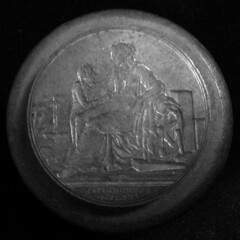

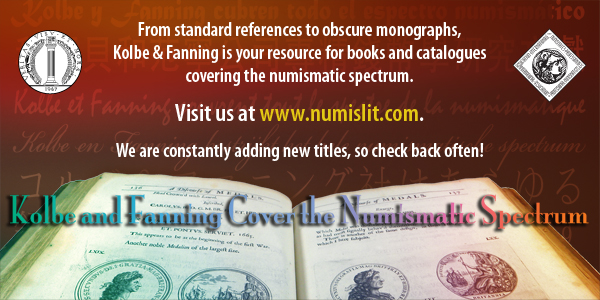
1887 DUNFERMLINE, SCOTLAND ATHLETIC MEDAL FOUND
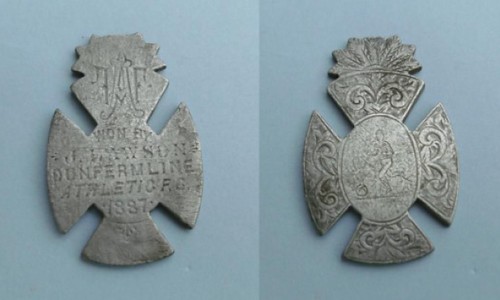
HOWARD BERLIN'S REPORT FROM GERMANY: GOETHE AND COIN ALLEY
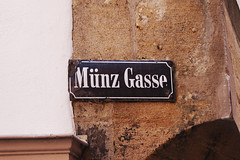 While in the Altstadt (old city), I came upon a narrow street, the Münz Gasse, or “coin alley” near the town square. Of what I could gather from a few shopkeepers there, there were several possible origins for the the Münz Gasse name. One was that the Tübingen penny of the Middles Ages was produced there.
While in the Altstadt (old city), I came upon a narrow street, the Münz Gasse, or “coin alley” near the town square. Of what I could gather from a few shopkeepers there, there were several possible origins for the the Münz Gasse name. One was that the Tübingen penny of the Middles Ages was produced there.
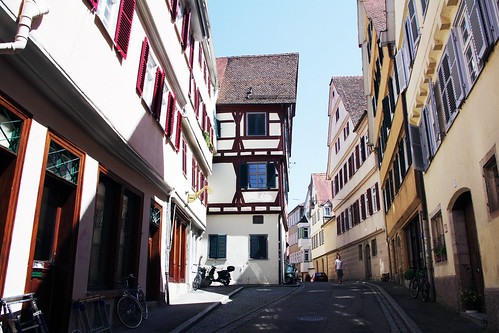
A view of the narrow “Coin Alley”
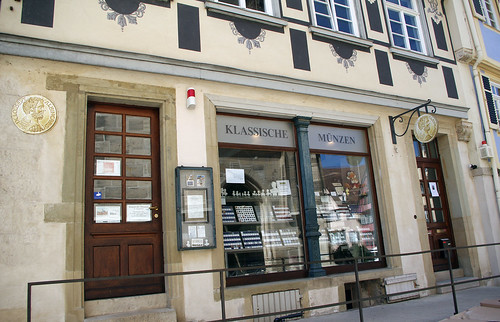
Dr. Brandt’s coin shop, Klassische Münzen
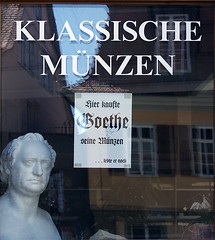

LANDEMUSEUM STUTTGART NUMISMATICS ON EXHIBIT
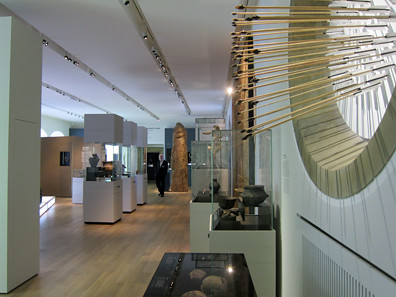
View inside the exhibition, section Early Neolithic.
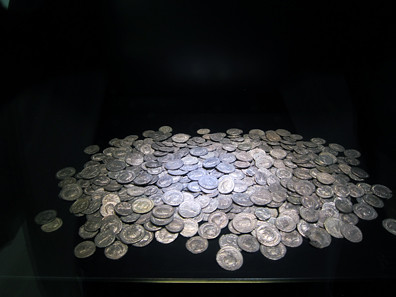
Treasure trove of Köngen, Esslingen district, 3rd cent. A. D.
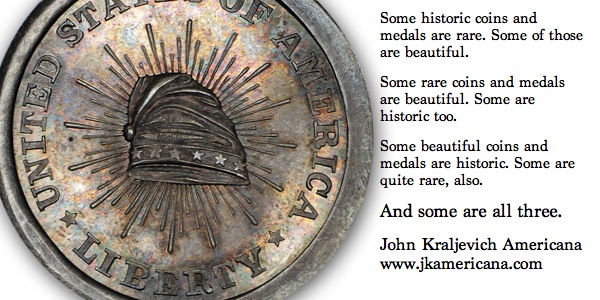
ANTONY AND CLEOPATRA COIN FOUND IN ISRAELI DIG
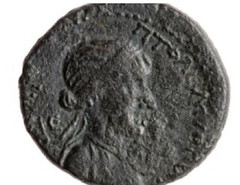 Found in an archaeological dig in Bethsaida, this rare bronze coin tells of love, trade ties and globe-shaking jealousies. And what if Marc Antony had won the war?
Found in an archaeological dig in Bethsaida, this rare bronze coin tells of love, trade ties and globe-shaking jealousies. And what if Marc Antony had won the war?
MEDIEVAL GOLD PENDANT IMITATES BYZANTINE GOLD SOLIDUS
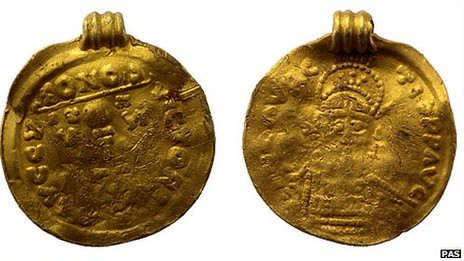
LAO INGOTS 1560-1895
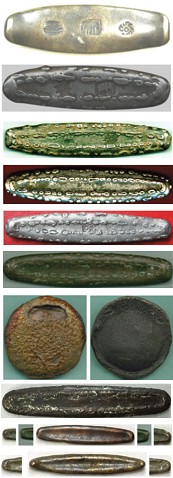 As many of you know, I have been collecting, researching and writing about Southeast Asian numismatics since 1964. As soon as I completed my recently published catalog on Cambodia, I started working on a Lao catalog and hope it will be published in December. I am also hoping that Lao ingots will be in future editions of the Krause Publications catalogs.
As many of you know, I have been collecting, researching and writing about Southeast Asian numismatics since 1964. As soon as I completed my recently published catalog on Cambodia, I started working on a Lao catalog and hope it will be published in December. I am also hoping that Lao ingots will be in future editions of the Krause Publications catalogs.
NEVADA RECLUSE'S GOLD COIN HOARD SOLD
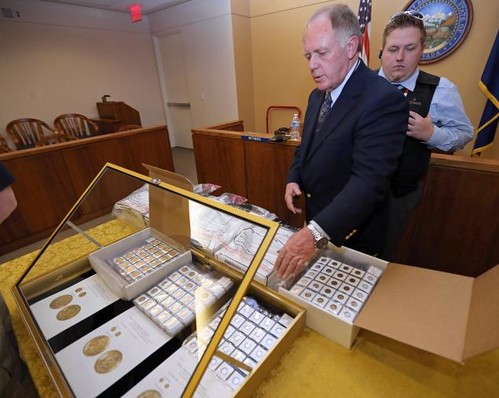
RUSSIAN MAN REWRITES TERMS OF HIS OWN CREDIT CARD
FEATURED WEB SITE: AMERICAN NUMISMATIC ASSOCIATION
This week's Featured Web Site is the American Numismatic Association.
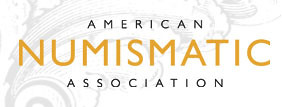
www.money.org
